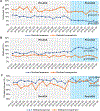The Association Between the Affordable Care Act and Insurance Status, Stage and Treatment in Patients with Testicular Cancer
- PMID: 34017908
- PMCID: PMC8130174
- DOI: 10.1097/upj.0000000000000109
The Association Between the Affordable Care Act and Insurance Status, Stage and Treatment in Patients with Testicular Cancer
Abstract
Purpose: We aimed to determine whether insurance expansions implemented through the Affordable Care Act (ACA) were associated with changes in coverage status, disease stage, and treatment of younger adults with testicular germ cell tumors (GCT).
Materials and methods: We identified men aged 18-64 diagnosed with testicular GCTs between 2010 and 2015 in the National Cancer Data Base. We defined time periods as: pre-ACA (2010-2013) and post-ACA (2014-2015) and used difference-in-differences (DID) modeling to examine associations between state Medicaid expansion status and changes in insurance, stage at diagnosis, and treatment.
Results: Following the ACA, the proportion of patients with any health insurance increased 3.7% (95% CI 3-4.5) in Medicaid expansion states and 3.0% (95% CI 1.5-4.5) in non-expansion states, mainly by gaining Medicaid and private insurance, respectively. The largest increases occurred in low-income patients, where Medicaid expansion was associated with an adjusted increase of 14.5 percentage points (95% CI 7.2-21.8) in Medicaid coverage following the ACA. We did not observe reductions in late-stage diagnoses during the observation period. Changes in the proportion of patients receiving chemotherapy or radiation for advanced-stage cancers were ongoing prior to the ACA and differed between expansion and non-expansion states, limiting assessment of ACA-related effects on individual treatments.
Conclusions: Post-ACA, the proportion of newly diagnosed testicular cancer patients with health insurance increased, with the largest effects seen among lowest income individuals. Our findings that changes in practice preceded the ACA and differed by expansion status highlight the need for caution in assessing the legislation's impact.
Keywords: Affordable Care Act; Medicaid Expansion; Testicular Cancer; Uninsurance.
Figures
Similar articles
-
Evaluation of Insurance Coverage and Cancer Stage at Diagnosis Among Low-Income Adults With Renal Cell Carcinoma After Passage of the Patient Protection and Affordable Care Act.JAMA Netw Open. 2021 Jul 1;4(7):e2116267. doi: 10.1001/jamanetworkopen.2021.16267. JAMA Netw Open. 2021. PMID: 34269808 Free PMC article.
-
Has the Affordable Care Act Been Associated with Increased Insurance Coverage and Early-stage Diagnoses of Bone and Soft-tissue Sarcomas in Adults?Clin Orthop Relat Res. 2021 Mar 1;479(3):493-502. doi: 10.1097/CORR.0000000000001438. Clin Orthop Relat Res. 2021. PMID: 32805094 Free PMC article.
-
Association of Medicaid Expansion With Health Insurance Coverage Among Persons With a Disability.JAMA Netw Open. 2019 Jul 3;2(7):e197136. doi: 10.1001/jamanetworkopen.2019.7136. JAMA Netw Open. 2019. PMID: 31314115 Free PMC article.
-
Insurance coverage, stage at diagnosis, and time to treatment following dependent coverage and Medicaid expansion for men with testicular cancer.PLoS One. 2020 Sep 16;15(9):e0238813. doi: 10.1371/journal.pone.0238813. eCollection 2020. PLoS One. 2020. PMID: 32936794 Free PMC article.
-
A Critical Analysis of Obamacare: Affordable Care or Insurance for Many and Coverage for Few?Pain Physician. 2017 Mar;20(3):111-138. Pain Physician. 2017. PMID: 28339427 Review.
Cited by
-
Evaluation of Insurance Coverage and Cancer Stage at Diagnosis Among Low-Income Adults With Renal Cell Carcinoma After Passage of the Patient Protection and Affordable Care Act.JAMA Netw Open. 2021 Jul 1;4(7):e2116267. doi: 10.1001/jamanetworkopen.2021.16267. JAMA Netw Open. 2021. PMID: 34269808 Free PMC article.
References
-
- Smith JCM, Carla. Health Insurance Coverage in the United States: 2014: United States Census Bureau; 2015.
-
- Sommers BD, Gunja MZ, Finegold K, Musco T. Changes in self-reported insurance coverage, access to care, and health under the affordable care act. JAMA. 2015;314:366–374. - PubMed
-
- Bleyer WA. Potential Favorable Impact of the Affordable Care Act of 2010 on Cancer in Young Adults in the United States. The Cancer Journal. 2010;16:563–571. - PubMed
-
- Kirchhoff AC, Lyles CR, Fluchel M, Wright J, Leisenring W. Limitations in health care access and utilization among long-term survivors of adolescent and young adult cancer. Cancer. 2012;118:5964–5972. - PubMed
Grants and funding
LinkOut - more resources
Full Text Sources
Medical



